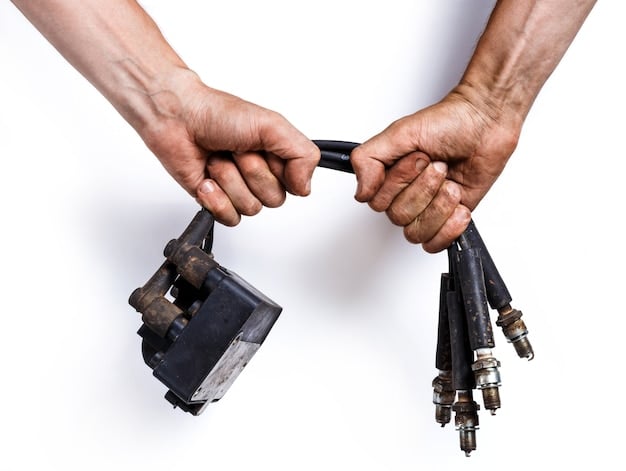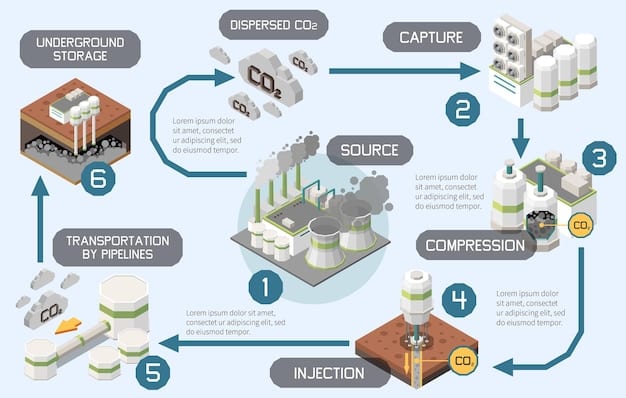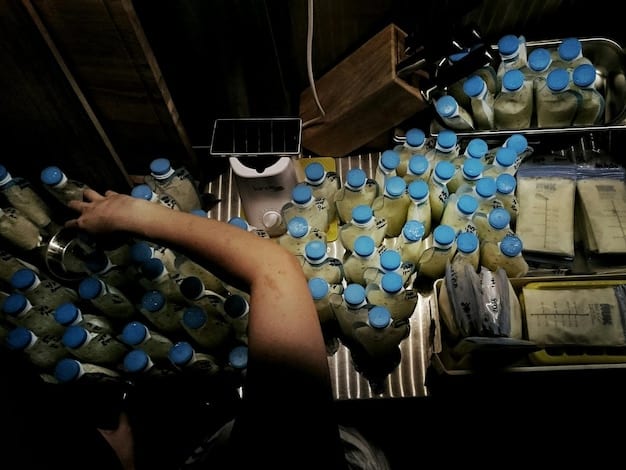Electric Vehicle Battery Recycling: Automakers’ Strategies in the US

Automakers in the US are addressing electric vehicle (EV) battery recycling challenges through investments in recycling technologies, partnerships with specialized recycling companies, and development of standardized battery designs to facilitate easier and more efficient recycling processes.
The rise of electric vehicles (EVs) has brought environmental benefits, but also a significant challenge: what to do with the batteries at the end of their lifespan? How are automakers addressing the challenges of electric vehicle battery recycling in the US, and what innovative strategies are they employing to create a sustainable future for EV technology?
The Growing Urgency of EV Battery Recycling
As electric vehicles become increasingly prevalent on US roads, the question of what happens to their batteries at the end of their life is becoming urgent. Projections indicate a massive influx of spent EV batteries in the coming years, raising serious environmental and economic concerns if not managed responsibly.
Without effective recycling strategies, the valuable materials within these batteries – lithium, cobalt, nickel, and manganese – could be lost, creating supply chain vulnerabilities and increasing the environmental footprint of EV production. Moreover, improper disposal of EV batteries poses risks of soil and water contamination.
Environmental and Economic Stakes
Effective EV battery recycling is essential for minimizing environmental impact and securing valuable resources. Recycling reduces the need for mining new materials, which can be environmentally destructive. Environmentally-sound recycling practices prevent harmful substances from leaching into the environment, safeguarding ecosystems and public health.
- Resource Recovery: Recycling allows the recovery of valuable materials like lithium, cobalt, and nickel, which can be reused in new batteries or other applications.
- Environmental Protection: Proper recycling prevents the release of toxic substances into the environment, protecting soil and water quality.
- Supply Chain Security: Recycling can reduce reliance on foreign sources of raw materials, enhancing the resilience of the domestic EV battery supply chain.
- Economic Opportunities: The EV battery recycling industry presents significant economic opportunities for companies involved in collection, processing, and materials recovery.
Automakers are aware of these stakes and are beginning to proactively address the need for effective EV battery recycling solutions.
Automakers’ Initial Investments in Recycling Technologies
Recognizing the critical need for efficient and sustainable battery recycling, several major automakers are making substantial investments in technologies aimed at improving the recycling process. These investments encompass a range of approaches, from hydrometallurgical to pyrometallurgical methods, each with its own set of advantages and challenges.
These investments demonstrate automakers’ commitment to addressing the challenges of EV battery recycling and contributing to a circular economy for battery materials.

Hydrometallurgical and Pyrometallurgical Methods
Currently, two dominant recycling methods are in development: hydrometallurgical and pyrometallurgical. Each holds promise, but also poses specific challenges.
Hydrometallurgical recycling involves using chemical solvents to dissolve and separate valuable battery components. This approach offers higher recovery rates for certain materials like lithium but can be energy-intensive and generate chemical waste.
- Hydrometallurgical Recycling: Uses chemical solutions to extract valuable materials, offering high recovery rates for lithium.
- Pyrometallurgical Recycling: Employs high temperatures to melt and separate metals, suitable for various battery chemistries.
- Direct Recycling: Focuses on refurbishing and reusing entire battery packs, extending their lifespan and reducing waste.
- Mechanical Recycling: Involves shredding and sorting battery components by material type, preparing them for further processing.
Conversely, pyrometallurgical recycling uses high temperatures to melt and separate metals. While this method is less selective and consumes more energy, it can handle a wider range of battery chemistries. Each method presents unique technical and financial hurdles.
Strategic Partnerships with Recycling Companies
Automakers may not want to tackle battery recycling entirely alone. Therefore, many are establishing strategic partnerships with companies specializing in battery recycling. These partnerships aim to combine the automakers’ expertise in battery technology and manufacturing with the recyclers’ specialized knowledge and infrastructure.
Through these collaborative efforts, automakers can leverage existing recycling infrastructure, share best practices, and accelerate the development of innovative recycling solutions.
Enhancing Recycling Efficiency
Strategic partnerships enhance recycling efficiency through dedicated recycling facilities and material processing. This improves scalability.
Working with expertise in environmentally conscious material handling is another benefit of automakers establishing partnerships with outside firms.

- Joint Ventures: Automakers form joint ventures with recycling companies to establish dedicated recycling facilities.
- Technology Sharing: Automakers share battery design and composition information with recyclers to optimize the recycling process.
- Supply Agreements: Automakers commit to supplying their end-of-life batteries to recycling partners, ensuring a steady stream of materials.
- Research Collaboration: Automakers and recyclers collaborate on research and development to improve recycling technologies and processes.
Many automakers rely on partnerships with recyclers to handle logistics, materials processing and chemical waste which can result from materials processing.
Designing Batteries for Recyclability
Another critical approach that automakers are adopting is designing batteries with recyclability in mind. This involves several key considerations, including standardizing battery formats, reducing the use of hazardous materials, and improving the ease of disassembly.
By incorporating design-for-recyclability principles early in the battery development process, automakers can significantly reduce the cost and complexity of recycling at the end of the battery’s lifespan. This can improve the economic viability of battery recycling and reduce the environmental impact of EV technology.
Standardization and Material Selection
Standardization efforts can improve efficiency and ease of battery recycling. Selecting greener materials is key to reducing negative environmental impact.
By improving the ease with which batteries can be disassembled, automakers improve opportunities for salvaging materials and components within batteries.
- Standardized Formats: Automakers adopt standardized battery formats to facilitate easier disassembly and processing at recycling facilities.
- Reduced Hazardous Materials: Automakers minimize the use of hazardous substances in battery manufacturing to simplify recycling and reduce environmental risks.
- Simplified Disassembly: Automakers design batteries for easier disassembly, enabling recyclers to quickly and efficiently separate valuable components.
- Material Labeling: Automakers implement clear material labeling on battery components to aid in sorting and processing at recycling facilities.
Automakers that account for the end-of-life realities of batteries during the design and manufacturing processes are much more likely to make battery recycling easier, more environmentally sensitive and potentially safer.
Overcoming Logistical Challenges in Battery Collection
One of the significant hurdles in EV battery recycling is the logistics of collecting spent batteries from various locations across the country. Batteries arrive not just from totaled cars, but also from warranty issues, or other problems requiring the battery pack to be removed from the vehicle.
Automakers are exploring various strategies to address this challenge, including establishing collection networks, incentivizing battery returns, and developing mobile recycling units. These initiatives aim to streamline the collection process and reduce the transportation costs associated with EV battery recycling.
Collection Networks and Incentives
By collaborating with dealers and repair shops to receive old batteries, automakers can improve the volume of batteries available for recycling while simplifying the recycling process.
Providing incentives for customers to participate in battery recycling programs may be another useful avenue for helping automakers more responsibly manage lithium-ion batteries.
- Collection Centers: Automakers establish regional collection centers where end-of-life batteries can be dropped off.
- Dealer Networks: Automakers leverage their dealer networks to collect batteries from customers and service centers.
- Incentive Programs: Automakers offer financial incentives or discounts for customers who return their end-of-life batteries for recycling.
- Mobile Recycling Units: Automakers deploy mobile recycling units to remote locations or events to collect batteries on-site.
These battery collection and recycling logistic issues are top-of-mind for the Environmental Protection Agency (EPA) and policymakers as well. By preemptively addressing these concerns, automakers demonstrate their commitment to sustainability.
Policy and Regulatory Landscape in the US
The success of EV battery recycling in the US will largely depend on the policy and regulatory landscape. Currently, there is no single federal law mandating EV battery recycling. However, several states are considering or have already implemented their own regulations to promote battery collection and recycling.
Automakers are actively engaging with policymakers to advocate for standardized and comprehensive recycling regulations that would create a level playing field and provide clear guidelines for the industry. This collaborative approach can help accelerate the development of a robust and sustainable EV battery recycling ecosystem in the US.
Federal and State Regulations
Understanding the present legal and regulatory environment is essential to assessing future opportunities for battery recycling. The current landscape is still evolving as federal and state legislators grapple with sustainability challenges.
“`html
| Key Point | Brief Description |
|---|---|
| ♻️ Recycling Urgency | Growing EV adoption necessitates efficient battery recycling to recover valuable materials. |
| 🤝 Partnerships | Strategic alliances with recycling firms enhance efficiency and scalability. |
| 🔋 Design for Recycling | Optimizing battery designs for easier disassembly and material recovery. |
| 🚚 Logistical Solutions | Establishing effective collection networks and incentives for battery returns. |
“`
“`html
FAQ
What are the primary methods for recycling EV batteries?
▼
Hydrometallurgical and pyrometallurgical processes are the primary methods. Hydrometallurgical uses chemicals, while pyrometallurgical uses high temperatures to extract materials.
How are automakers partnering with recycling companies?
▼
Automakers form joint ventures, share battery tech data, commit to supplying batteries, and collaborate on research with recycling companies.
Why is battery design important for recycling?
▼
Designing batteries for recyclability simplifies disassembly, reduces hazardous material use, and uses standardized formats, improving recycling efficiency.
What logistical challenges exist in EV battery recycling?
▼
Logistical challenges include establishing collection networks, incentivizing returns, and developing efficient transportation systems for batteries across the US.
What policies are being developed to address EV battery recycling?
▼
Various states consider or implement their own regulations to promote battery collection and recycling. Engagement with policymakers ensures effective policies are put in practice.
“`
Conclusion
Addressing the challenges of electric vehicle battery recycling in the US requires a multifaceted approach. Automakers are investing in advanced recycling technologies, forging strategic partnerships, designing batteries for recyclability, and tackling logistical hurdles. By embracing these strategies and collaborating with policymakers, automakers can pave the way for a sustainable and circular future for EV technology.
“`html
Read more content
“`





